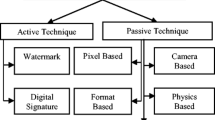Abstract
The reliability of CCTV digital images is more important than the reliability of many other types of images. However, image editing tools such as Photoshop make this unreliable. CCTV uses two photography modes, the RGB mode and the near-infrared mode. While near-infrared images have different properties, such as a constant level of source light intensity, and a constant direction of the source light, there are no forensic techniques for near-infrared images. In this paper, we propose a forensic technique based on a constant direction of the source light. In order to expose splicing forgery in near-infrared images, we create an ideal near-infrared image model of a plane. We then calculate gradient vectors of the model and objects in images. Depending on the similarity of two vectors, the image is determined forged or not. This forensic technique helps to improve the reliability of near-infrared images.




























Similar content being viewed by others
References
Choi CH, Lee HY, Lee HK (2013) Estimation of color modification in digital images by cfa pattern change. Forensic Sci Int 226(1):94–105
Dorsey, J., Rushmeier, H., Sillion, F.X. (2007): Digital modeling of material appearance. The Morgan Kaufmann series in computer graphics. Morgan Kaufmann
Fridrich, A.J., Soukal, B.D., Lukas, A.J. (2003) Detection of copy-move forgery in digital images. In: in Proceedings of Digital Forensic Research Workshop. Citeseer
Gill, M., Spriggs, A., Britain, G. (2005) Assessing the impact of CCTV. Home office research, development and statistics directorate London
He J, Lin Z, Wang L, Tang X (2006) Detecting doctored jpeg images via dct coefficient analysis. Computer Vision–ECCV:423–435 Springer (2006)
Hyun DK, Ryu SJ, Lee HY, Lee HK (2013) Detection of upscale-crop and partial manipulation in surveillance video based on sensor pattern noise. Sensors 13(9):12,605–12,631
Johnson, M.K., Farid, H. (2005) Exposing digital forgeries by detecting inconsistencies in lighting. In: Proceedings of the 7th workshop on Multimedia and security, pp. 1–10. ACM
Johnson MK, Farid H (2007a) Exposing digital forgeries in complex lighting environments. IEEE Trans Inf Forensics Secur 2(3):450–461
Johnson, M.K., Farid, H. (2007b) Exposing digital forgeries through specular highlights on the eye. In: Information Hiding, pp. 311–325. Springer
Kee, E., OBrien, J., Farid, H. (2014) Exposing photo manipulation from shading and shadows. ACM Trans. Graph. (in press 2014)
Kirchner, M., Gloe, T. (2009) On resampling detection in re-compressed images. In: information forensics and security, 2009. WIFS 2009. First IEEE international workshop on, pp. 21–25. IEEE
Li, B., Shi, Y.Q., Huang, J. (2008) Detecting doubly compressed jpeg images by using mode based first digit features. In: Multimedia Signal Processing, 2008 I.E. 10th Workshop on, pp. 730–735. IEEE
Lukas, J., Fridrich, J., Goljan, M. (2006) Detecting digital image forgeries using sensor pattern noise. In: electronic imaging 2006, pp. 60,720Y–60,720Y. International Society for Optics and Photonics
Piva, A. (2013) An overview on image forensics. ISRN Signal Process 2013
Shi, Y.Q., Chen, C., Chen, W. (2007) A natural image model approach to splicing detection. In: Proceedings of the 9th workshop on Multimedia & security, pp. 51–62. ACM
Stamm MC, Liu K (2010) Forensic detection of image manipulation using statistical intrinsic fingerprints. IEEE Trans Inf Forensics Secur 5(3):492–506
Stamm MC, Wu M, Liu K (2013) Information forensics: an overview of the first decade. Access, IEEE 1:167–200
Taylor, A.E., et al. (2000) Illumination fundamentals. Lighting research center, Rensselaer Polytechnic Institute
Yerushalmy I, Hel-Or H (2011) Digital image forgery detection based on lens and sensor aberration. Int J ComputVision 92(1):71–91
Acknowledgments
This work was supported by Institute for Information & communications Technology Promotion(IITP) grant funded by the Korea government(MSIP) (No. B0717-16-0135, Fundamental Research on Deep Learning based Complex Digital Image Forgery Detection).
Author information
Authors and Affiliations
Corresponding author
Rights and permissions
About this article
Cite this article
Park, JS., Hyun, DK., Hou, JU. et al. Detecting digital image forgery in near-infrared image of CCTV. Multimed Tools Appl 76, 15817–15838 (2017). https://doi.org/10.1007/s11042-016-3871-7
Received:
Revised:
Accepted:
Published:
Issue Date:
DOI: https://doi.org/10.1007/s11042-016-3871-7




